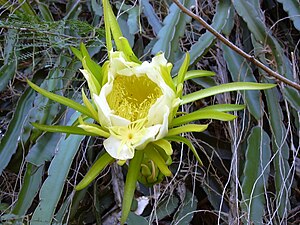Hylocereus undatus
| Hylocereus undatus | ||||||||||||
|---|---|---|---|---|---|---|---|---|---|---|---|---|

Hylocereus undatus |
||||||||||||
| Systematics | ||||||||||||
|
||||||||||||
| Scientific name | ||||||||||||
| Hylocereus undatus | ||||||||||||
| ( Haw. ) Britton & Rose |
Hylocereus undatus is a species of the genus Hylocereus from the cactus family(Cactaceae). The specific epithet undatus is derived from the Latin noun unda for 'wave'. Common names are "Chacam", "Chak-Wob", "Dragon Fruit", "Junco Tapatío", "Pitahaya", "Pitahaya Orejona", "Queen of the Night", "Tasajo" and "Zacamb".
description
Hylocereus undatus grows stretched out or climbing with a dense tangle of triangular, strong and articulated shoots and reaches a length of 5 meters and more with a diameter of 4 to 7.5 centimeters. The shoots are wavy and horny on the back of the ribs. There are 1 to 3 short, conical, brownish-gray spines that are up to 3 millimeters long.
The white flowers appearing along the entire shoots are 25 to 27 centimeters long and have a diameter of 15 to 20 centimeters. The tasty, pink-magenta-colored fruits , traded in Germany under the collective name " dragon fruit " or " pitahaya ", are spherical to oblong, 5 to 12 centimeters long and have a diameter of 4 to 9 centimeters.
Systematics and distribution
Hylocereus undatus is believed to have originally come from southern Mexico and is now widespread in the tropics of the New World. In many countries, for example in Southeast Asia, the species is cultivated and has partly become wild there.
The first description as Cereus undatus was published in 1830 by Adrian Hardy Haworth . Nathaniel Lord Britton and Joseph Nelson Rose placed them in the genus Hylocereus in 1918 .
Cultivation
The growing areas include the tropical and subtropical America, South Florida, the Caribbean, Hawaii, various areas of Asia, Australia, Taiwan, Vietnam, Malaysia and Israel. The plants thrive in subtropical or tropical climates. They are usually propagated from cuttings and cultivated on loose dry soil, or as epiphytes on trees, fences or walls. The cactus can bear fruit all year round. The cuttings grow very quickly (up to 3 cm per day) and, under favorable conditions, can produce fruit after 6–9 months. A three to four year old plant can produce up to 100 kg of fruit per year. The life span of the cultivated plants is given as about 20 years.
Danger
To assess their hazard degree of Hylocereus undatus of lying Red List of Threatened Species of IUCN from data adequately.
proof
literature
- NL Britton , JN Rose : The Cactaceae. Descriptions and Illustrations of Plants of the Cactus Family . tape II . The Carnegie Institution of Washington, Washington 1920, p. 187-188 ( online ).
- Edward F. Anderson : The Great Cactus Lexicon . Eugen Ulmer KG, Stuttgart 2005, ISBN 3-8001-4573-1 , p. 345 .
Individual evidence
- ^ Philosophical Magazine . Volume 7, London 1830, p. 110 ( online ).
- ↑ Flora of Bermuda . 1918, p. 256 ( online ).
- ^ A b Jonathan H. Crane, Carlos F. Balerdi: Pitaya (Dragonfruit) Growing in the Florida Home Landscape. (pdf) Horticultural Sciences Department, University of Florida / Institute of Food and Agricultural Sciences (IFAS), accessed on August 2, 2020 .
- ↑ Bernd Nowak, Bettina Schulz: Pocket dictionary of tropical useful plants and their fruits . Quelle & Meyer Verlag, 2009, ISBN 978-3-494-01455-5 , Hylocereus undatus (Haworth) Britton & Rose, p. 302-303 .
- ^ Hylocereus undatus in the IUCN Red List of Threatened Species 2013.1. Retrieved October 15, 2013.
